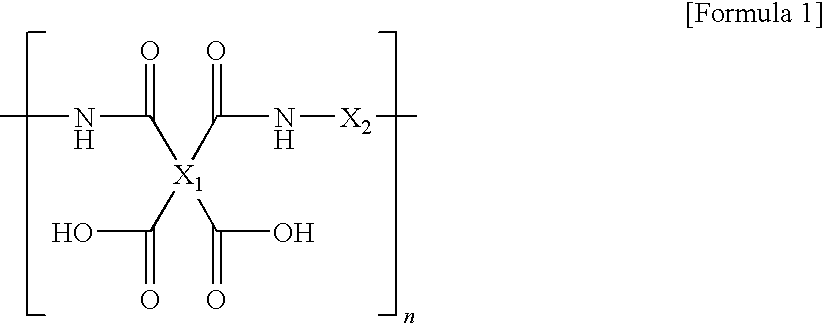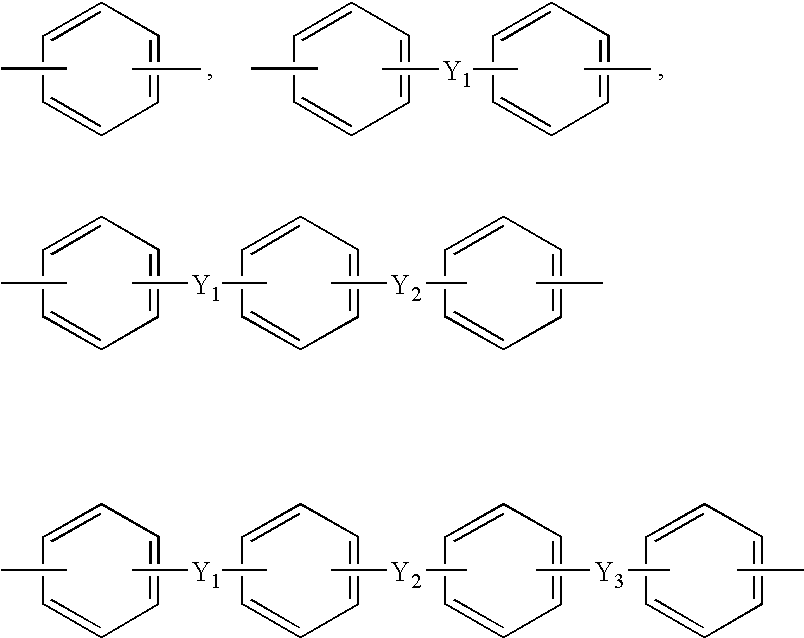Alkali developable photosensitive resin composition and dry film manufactured by the same
- Summary
- Abstract
- Description
- Claims
- Application Information
AI Technical Summary
Benefits of technology
Problems solved by technology
Method used
Image
Examples
example
Production of the Polyamic Acid
Preparation Example 1 (PAA1)
[0092]While nitrogen flew into the four neck round bottom flask that was provided with the thermometer, the agitator, the nitrogen input port, and the powder dispensing funnel, 780 g of N,N-dimethyl acetamide (DMAc) was added to 23.24 g of 4,4′-oxydianiline (4,4′-ODA) and 79.16 g of 1,3-bis(4-aminophenoxy)benzene (TPE-R)), and agitated to completely dissolve. The solution was cooled to not more than 15° C., 117.60 g of 4,4′-oxydiphthalic anhydride (ODPA) was slowly added and agitated to obtain the polyamic acid varnish.
preparation example 2 (
PAA2)
[0093]90.45 g of 2,2′-bis(4-[3-aminophenoxy]phenyl)sulfone (m-BAPS) and 27.92 g of 4,4′-oxydianiline (4,4′-ODA) were used as diamine, and 101.63 g of 3,3′,4,4′-biphenyltetracarboxylic dianhydride (BPDA) was used as dianhydride to obtain the polyamic acid varnish by using the same method as Preparation Example 1.
preparation example 3 (
PAA3)
[0094]23.48 g of 4,4′-oxydianiline (4,4′-ODA) and 79.99 g of 1,3-bis(4-aminophenoxy)benzene (TPE-R) were used as diamine, and 37.22 g of 3,3′,4,4′-benzophenone tetracarboxylic dianhydride (BTDA) and 79.30 g of 3,3′,4,4′-biphenyltetracarboxylic dianhydride (BPDA) was used as dianhydride to obtain the polyamic acid varnish by using the same method as Preparation Example 1.
PUM
| Property | Measurement | Unit |
|---|---|---|
| Percent by mass | aaaaa | aaaaa |
| Percent by mass | aaaaa | aaaaa |
| Percent by mass | aaaaa | aaaaa |
Abstract
Description
Claims
Application Information
 Login to View More
Login to View More - R&D
- Intellectual Property
- Life Sciences
- Materials
- Tech Scout
- Unparalleled Data Quality
- Higher Quality Content
- 60% Fewer Hallucinations
Browse by: Latest US Patents, China's latest patents, Technical Efficacy Thesaurus, Application Domain, Technology Topic, Popular Technical Reports.
© 2025 PatSnap. All rights reserved.Legal|Privacy policy|Modern Slavery Act Transparency Statement|Sitemap|About US| Contact US: help@patsnap.com



